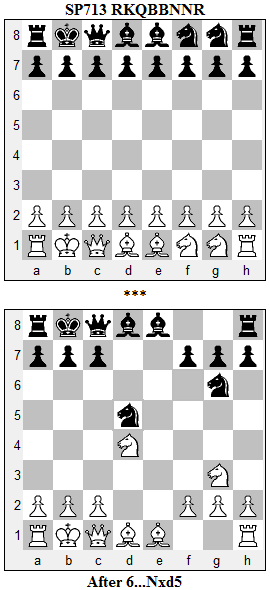I liked Finegold - Kosteniuk a lot. As far as I remember, Finegold was very happy with the game.
That game was played in round two, so I reviewed the commentary preserved in video for that round. The start position SP713 RKQBBNNR, shown in the first diagram below, sparked some immediate commentary.
YS (GM Yasser Seirawan): I always find it difficult when either of the Bishops are on e1 or d1. In this particular position, both Bishops are on the center squares. In order to control the center, you're going to have to bring those Bishops out.JS (WGM Jennifer Shahade): What is it you don't like about the Bishops on d1 and e1? • YS: Let's take the Bishop on e1 for instance. In this particular position Martha [Fierro] opened 1.e4. How is she going to develop the Bishop on e1? How is she going to develop the Bishop on f3? It would be great if White could play both e4 and d4, followed by Bf3 and Bc3 together. But after the logical response 1...e5, it's hard to get in d4, Bc3, and Bf3. The move 1.e4 opened up the Bishop on d1 to be developed, but after Nf3, a very natural move, the Bishop on d1 still hasn't been solved. Also, once you've played Nf3, the Bishop on e1 has another problem: how is it going to solve its development? [...] It's almost tortoise-like to get your Bishops off d1 and e1. Black, of course, has the same difficulties.
The Finegold - Kosteniuk game, won by White in 25 moves, started 1.e4 e5 2.Nf3 Ng6 3.d4. When it was over, GM Ben Finegold chatted with the commentators about his impressions during the game.
BF: Normally, I don't play the Scotch, but I thought it was funny in chess960 to do that. • JS: It's also funny how people keep referring to the openings by their chess names.
3...exd4 4.Nxd4 Nf6 5.Ng3 d5
BF: The move ...d5 surprised me. Then we were symmetrical.
6.exd5 Nxd5. (See the second diagram.)

7.Bf3
BF: It seems like I'm better because I can castle O-O quickly and when my Queen goes to e3, Black can't move her Queen out, so I've stopped her from castling O-O. It's weird. I had a symmetrical position against Anna [Zatonskih] yesterday and I was much worse with Black. Here is also a symmetrical position and Black is worse. We got double edged positions.
7...Nb6
YS: We thought in case of 7...Bf6, you get one of those positions where you're a tempo up in a symmetrical position and after castling that tempo might be meaningful. • BF: Maybe a tempo and a half, because the Bishop has to move.8.Qe3 Bf6 9.Nh5 Be5 10.Bc3 Na4 11.O-OBF: I expected 7...Nb6, because I wanted to play Bc3. Then ...Na4 seems annoying, but I realized I have this bxc3 idea. That's not the way I play chess, but if the King is on b8 and you can't castle, then I'll play that way.
YS: This is the longest King move you've made in your career.
After a few more moves, everyone agreed that Black's position was 'really bad'. Black couldn't even castle O-O-O because of Qxa7. The game ended when Black overlooked mate in one.
JS: How do you like playing chess960 so far? • BF: I like the results, but I don't know if I'm a big fan yet. As soon as the position is set up, I just stare at it until the bell rings [to start the game]. OK, g2 is hanging. That's what I figured out before the game. Does that matter? I don't see how Black is going to take on g2, but don't lose it in the first five moves, because that's embarrassing. • JS: Some great chess960 tips here!
Yes, some great tips indeed.

2 comments:
Black got into trouble because of bad Chess960 technique.
2....Ng6?! was passive because activation of the knight from there is questionable, black's g-side cannot be developed and the queen is entombed.
This is where Chess960 thinking comes into play. The queen must have a path to freedom and the light bishop cannot be freed via the g-side. 2...d6 does three things! Gives a development path for Q+B and protects e5. And for those players of black that like action (Nakamura!), black had another choice 2)...Nf6!? defying the need to protect the pawn at all.
In summary, there were simple moves that black could have played. It just required a Chess960 mentality which comes with practice.
On another topic. The future of Chess960 looks good! Nakamura is playing wonderfully positive openings as white against the very best in the world at Bilbao. His Chess960 mentality is putting him in good stead and his gut feel of how to play the opening is wonderful! Naka is a member of the St Louis Chess Club and lives in St Louis. If he continues on this form, the willingness of the St Louis club to play Chess960 because of Naka's interest in it, will mean 960 tournaments will follow at the great club, and Bobby Fischers greatest invention will be released from it's shackles where ultra conservationism and unimaginative adherence to the old ways hold it back today.
Cheers
All FRC-chess960 games (for the next couple of decades) should reuse the setup RNBBKNQR S#549: reachable by legal moves after 1. e3 e6.
One STABLE nontraditional setup is needed, so we can observe new opening systems grow.
Lose the "Random", keep the "Fischer Chess".
GeneM, 2011/Oct/16
CastleLong.com
Post a Comment